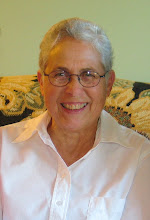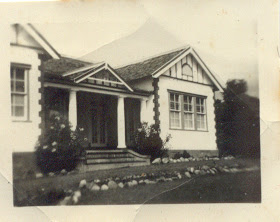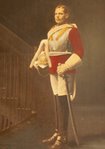Some time after I started researching my family I realized that I knew far more about my mother's family than I did about my father's. My Dad did not talk about his family very much. My mother told me what little she knew and my Uncle Rodney contributed information as well. As I've mentioned before, I did know my Grandmother Levy as a child. She lived across from my mother's family, the Smedmores, at 22 Beeston Street, on the south-west corner of Beeston Street and Love Lane.
 I remember visiting her as a young child with my parents, but I don't think we went there very often. We seemed to spend more time with my mother's family. I don't know the reason for this, but I suspect my mother was somewhat resentful of her mother-in-law. The story I was told was that she and my father had been engaged for seven years before they could get married because my father had to support his mother and help pay the mortgage on her house. My grandmother was a widow. Her husband had died a long time ago and my father's three siblings had taken off for the United States so he was the only one left to take care of her. Another possible reason for this lack of closeness was that my grandmother was Catholic and my mother was a staunch Anglican, and though it seems strange in these days of ecumenicism, back then there was separation between denominations of the Christian religion. In fact, there were even differences of opinion between high-church and low-church Anglicans!
I remember visiting her as a young child with my parents, but I don't think we went there very often. We seemed to spend more time with my mother's family. I don't know the reason for this, but I suspect my mother was somewhat resentful of her mother-in-law. The story I was told was that she and my father had been engaged for seven years before they could get married because my father had to support his mother and help pay the mortgage on her house. My grandmother was a widow. Her husband had died a long time ago and my father's three siblings had taken off for the United States so he was the only one left to take care of her. Another possible reason for this lack of closeness was that my grandmother was Catholic and my mother was a staunch Anglican, and though it seems strange in these days of ecumenicism, back then there was separation between denominations of the Christian religion. In fact, there were even differences of opinion between high-church and low-church Anglicans!
The stories I was told about my grandfather were that he was a Jew from Alsace, an oculist by trade, and that he travelled throughout the Caribbean and Central and South America. He is supposed to have brought back a gold nugget from Brazil which was made into two signet rings, one each for my brother and myself. This is a picture of my ring --
 It is engraved with three of my four initials, D M L, intertwined. Did the gold nugget really come from Brazil? I have no evidence that he was ever in South America. The few records that I have for him show him in Port-au-Prince, Haiti; Colon, Panama; and Cuba, where he died. My grandfather was indeed a mystery.
It is engraved with three of my four initials, D M L, intertwined. Did the gold nugget really come from Brazil? I have no evidence that he was ever in South America. The few records that I have for him show him in Port-au-Prince, Haiti; Colon, Panama; and Cuba, where he died. My grandfather was indeed a mystery.Here's what I was told about him by my mother, who, by the way, never knew him as he had died some years before my parents married. His name was Leopold Levy and my father was given the name, Leopold, as a middle name. Leopold could speak seven languages ... again I wonder about this. Certainly he would have spoken French and most likely German, coming as he did from Alsace, a country which has bounced back and forth between France and Germany. He certainly would have spoken English and no doubt Spanish as he spent a great deal of his time in Spanish-speaking countries. I assume that as a Jew he may have spoken Yiddish ... that makes five languages and I've no idea what the other two would have been. I was told also that he was an oculist, and in fact that is stated in my father's entry in Who's Who Jamaica. Yet, in the few records I found that name Leopold his occupation is invariably given as "clerk", "bookkeeper", or "merchant".
How and where did he meet my grandmother? Well, that was another story, this time from my Uncle Rodney who told me that they had married in Haiti. What was my grandmother, Alice Rodrigues Da Costa, doing in Haiti? According once more to Rodney, she was operating a ferry service between Kingston and Haiti! I have not so far found any evidence of this. How many children did they have? Seven, I was told, but three had died young. And then there was this fanciful tale that Leopold had insisted the first child be brought up Jewish, but she died so he stated that the rest might as well be brought up Catholic! It sounded feasible, except that certain questions kept popping up in my mind. First of all, my grandmother was Catholic and Leopold was Jewish, so who would have married them? At that time I didn't think either the Jews or the Catholics would have done so. Secondly, if they were married in the Catholic Church then wouldn't Leopold have had to agree to bring up the children as Catholics? Finally, no child of this marriage would have been named in the synagogue as the mother was not Jewish. And the tale was pretty well disproved after I discovered a baptism, performed by Father William Spillman, S. J., in Holy Trinity Catholic Church in Kingston for the eldest child, Daisy Agatha.

So, here's what I knew so far. My grandfather, Leopold Levy, came from Alsace; met my grandmother in Haiti and married her; they had seven children and he died in Cuba. As for the children the names I had were Daisy, Lucien and Gustave, all of whom died in infancy, and the remaining four were my father, Michael, and his siblings, Essie, Leo and Joe, all three of whom moved to the United States. When I began researching the family I started with birth records for the children, all of whom were born in Kingston, between 1886 and 1900, and it was not difficult to find registrations of their births in the microfilm records of the Church of Jesus Christ of Latter-day Saints (LDS), aka Mormons. I have spent a great deal of time at an LDS Family History Centre and I am grateful to the Mormons for microfilming many Jamaican records, including Church of England parish records as well as the civil registration of births, marriages and deaths. I found birth records for all seven children and was therefore able to sort out their birth order: Daisy, born September 1886, died December 1887; Lucien, born November 1887, died April 1890, my father, Michael, born August 1889; Essie, born March 1891; Gustave, born May 1894, died December 1899; Leo, born July 1895; and Joe, born January 1900.
Whenver anyone asks me how to begin doing their family history I always repeat the well-known axiom: "Start with yourself and work back". Another one is: "Talk to your relatives and ask them questions." Good advice! I certainly did. But the next good piece of advice is: "Look for the records which should confirm that what you have been told is true". (I should make one thing clear ... I didn't really get started on the research until many years after I was told the "facts", so was unable to share the results of my research with my family as they were no longer alive.)
I was somewhat stumped by the fact that my grandparents had got married in Haiti. I had no idea where in Haiti they were married -- Port au Prince was a possibility, but how to get the record? I assumed that the marriage must have taken place around 1885 as Daisy was born in September 1886, but for the longest time I had no proof of this particular fact, and then I had an email from Madeleine Mitchell, an indefatigable Jamaican researcher who is also the co-ordinator for the Jamaican Genealogy page on Rootsweb. Madeleine had been going through microfilm of the Jamaica Gleaner and had come across something of interest to me in the paper for 1886. (I also for a while went through the early issues of the Gleaner on microfilm, which I got on interlibrary loan from the Library of Congress, but at the time that I heard from Madeleine I had not yet got to that year. Now that the Gleaner is digitized and on line it is less onerous to search.) Madeleine had found evidence of the marriage of my grandparents, and it wasn't what I was told! They had not married in Haiti; in fact, the marriage took place in Colon, Panama, and not in 1885, but in July 1886! Here is a copy of the notice as it appeared in the Gleaner of July 23, 1886:
 So, there was one "fact" proved wrong. I now had what appeared to be something of a scandal in the family, in that my grandmother was some seven months pregnant when she got married! Which brings up another question, namely, when and where did Alice meet Leopold? Was he living in Jamaica and then took off for Colon, as a result of which Alice went after him? She did return to Jamaica as Daisy was born there at 106 King Street. A Mrs. Jacob Rodrigues Da Costa was the informant on the birth record and Leopold's occupation was given as "merchant of Colon".
So, there was one "fact" proved wrong. I now had what appeared to be something of a scandal in the family, in that my grandmother was some seven months pregnant when she got married! Which brings up another question, namely, when and where did Alice meet Leopold? Was he living in Jamaica and then took off for Colon, as a result of which Alice went after him? She did return to Jamaica as Daisy was born there at 106 King Street. A Mrs. Jacob Rodrigues Da Costa was the informant on the birth record and Leopold's occupation was given as "merchant of Colon".
So it turns out that finding that piece of information brought up more questions than I had previously, such as, who was Mrs. Jacob Rodrigues Da Costa? The answer to this would lead me to a whole new family that I knew nothing of previously, but before that I would investigate the Levy family more thoroughly.

 Why did the family move around so much? Again, this is not usual. My research has found that families usually seemed to stay in one spot, so it was quite common to see children being born at the same address over the years. This would, of course,indicate that the family in question owned their home. I believe that the Levy family must have been renters and more than likely were not financially secure. Certainly if Leopold was away a great deal money may have been tight. Eventually my grandmother Alice would own a home, at 22 Beeston Street, but I do not know when this was purchased. When Joe emigrated to the United States in 1917 he gave his mother as next of kin and that was the address that was listed for her on the ship's manifest. I know that my father helped her to pay the mortgage on the house before he was married.
Why did the family move around so much? Again, this is not usual. My research has found that families usually seemed to stay in one spot, so it was quite common to see children being born at the same address over the years. This would, of course,indicate that the family in question owned their home. I believe that the Levy family must have been renters and more than likely were not financially secure. Certainly if Leopold was away a great deal money may have been tight. Eventually my grandmother Alice would own a home, at 22 Beeston Street, but I do not know when this was purchased. When Joe emigrated to the United States in 1917 he gave his mother as next of kin and that was the address that was listed for her on the ship's manifest. I know that my father helped her to pay the mortgage on the house before he was married.





















































